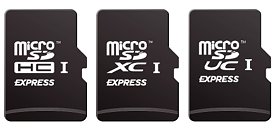- Joined
- Oct 9, 2007
- Messages
- 47,427 (7.51/day)
- Location
- Hyderabad, India
| System Name | RBMK-1000 |
|---|---|
| Processor | AMD Ryzen 7 5700G |
| Motherboard | ASUS ROG Strix B450-E Gaming |
| Cooling | DeepCool Gammax L240 V2 |
| Memory | 2x 8GB G.Skill Sniper X |
| Video Card(s) | Palit GeForce RTX 2080 SUPER GameRock |
| Storage | Western Digital Black NVMe 512GB |
| Display(s) | BenQ 1440p 60 Hz 27-inch |
| Case | Corsair Carbide 100R |
| Audio Device(s) | ASUS SupremeFX S1220A |
| Power Supply | Cooler Master MWE Gold 650W |
| Mouse | ASUS ROG Strix Impact |
| Keyboard | Gamdias Hermes E2 |
| Software | Windows 11 Pro |
The SD Association announced today microSD Express, offering the popular PCI Express and NVMe interfaces alongside the legacy microSD interface for backwards compatibility. Like SD Express, microSD Express uses the PCIe interface delivering a 985 megabytes per second (MB/s) maximum data transfer rate and the NVMe upper layer protocol enables advanced memory access mechanism, enabling a new world of opportunities for mobile devices.
microSD Express cards defined in the SD 7.1 specification will be offered in a variety of capacities such as microSDHC Express, microSDXC Express and microSDUC Express. "microSD Express gives the mobile industry a compelling new choice to equip mobile devices with removable SSDs," said Hiroyuki Sakamoto, SDA president. "SD 7.1 prepares consumers and mobile device manufacturers to meet ever increasing storage demands for years to come."

"PCI-SIG is pleased to continue our collaboration with the SDA on this newest innovation for the world's leading removable memory card - microSD," said Al Yanes, PCI-SIG president and chairman. "PCIe specification conformance tests are available today by major test vendors, offering a significant advantage for any new PCIe adopter."
microSD Express delivers speeds necessary to transfer large amounts of information generated by data-intense wireless communication, speed hungry applications running on cards and mobile computing devices, ever evolving gaming systems, multi-channel IoT devices, numerous automotive uses, higher resolution mobile videos, action cameras, 360o videos, VR and more.
"NVMe is the industry-recognized performance SSD interface from the client to the data center to mobile, shipping in millions of units," said Amber Huffman, NVM Express Inc. president. "By SDA adopting NVMe technology into the new microSD Express cards, users can experience lower latency and increasingly fast transfer speeds across various applications."
microSD Express uses the well-known PCIe 3.1 and NVMe v1.3 specifications defined by PCI-SIG and NVM Express, respectively, on the second row of pins. PCIe 3.1 includes the low power sub-states (L1.1, L1.2) enabling low power implementations of SD Express for the mobile market. In addition, SD Express cards with significantly higher speed data transfer rates are expected to consume less energy than traditional microSD memory cards while keeping the same maximum consumed power. The cards provide system developers new options offered by PCIe and NVMe capabilities, such as Bus Mastering, Multi Queue (without locking mechanism) and Host Memory Buffer. By relying on successful protocols already in the marketplace, the SDA gives the industry an advantage allowing utilization of existing test equipment and saving in development process by usage of existing building blocks used in existing designs.
The SDA released visual marks to denote microSD Express memory cards to make matching the card and device easier for optimal device performance.
For more information, access the whitepaper (PDF) here.
View at TechPowerUp Main Site
microSD Express cards defined in the SD 7.1 specification will be offered in a variety of capacities such as microSDHC Express, microSDXC Express and microSDUC Express. "microSD Express gives the mobile industry a compelling new choice to equip mobile devices with removable SSDs," said Hiroyuki Sakamoto, SDA president. "SD 7.1 prepares consumers and mobile device manufacturers to meet ever increasing storage demands for years to come."

"PCI-SIG is pleased to continue our collaboration with the SDA on this newest innovation for the world's leading removable memory card - microSD," said Al Yanes, PCI-SIG president and chairman. "PCIe specification conformance tests are available today by major test vendors, offering a significant advantage for any new PCIe adopter."
microSD Express delivers speeds necessary to transfer large amounts of information generated by data-intense wireless communication, speed hungry applications running on cards and mobile computing devices, ever evolving gaming systems, multi-channel IoT devices, numerous automotive uses, higher resolution mobile videos, action cameras, 360o videos, VR and more.
"NVMe is the industry-recognized performance SSD interface from the client to the data center to mobile, shipping in millions of units," said Amber Huffman, NVM Express Inc. president. "By SDA adopting NVMe technology into the new microSD Express cards, users can experience lower latency and increasingly fast transfer speeds across various applications."
microSD Express uses the well-known PCIe 3.1 and NVMe v1.3 specifications defined by PCI-SIG and NVM Express, respectively, on the second row of pins. PCIe 3.1 includes the low power sub-states (L1.1, L1.2) enabling low power implementations of SD Express for the mobile market. In addition, SD Express cards with significantly higher speed data transfer rates are expected to consume less energy than traditional microSD memory cards while keeping the same maximum consumed power. The cards provide system developers new options offered by PCIe and NVMe capabilities, such as Bus Mastering, Multi Queue (without locking mechanism) and Host Memory Buffer. By relying on successful protocols already in the marketplace, the SDA gives the industry an advantage allowing utilization of existing test equipment and saving in development process by usage of existing building blocks used in existing designs.
The SDA released visual marks to denote microSD Express memory cards to make matching the card and device easier for optimal device performance.
For more information, access the whitepaper (PDF) here.
View at TechPowerUp Main Site




